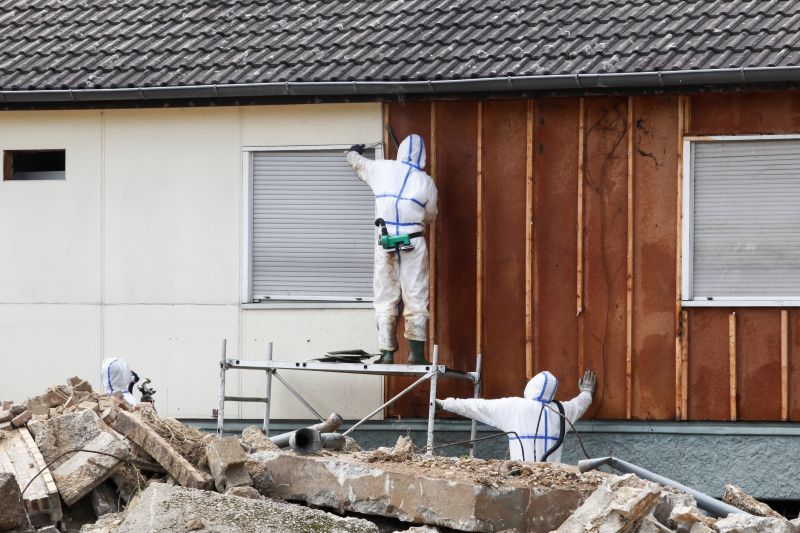Expert Picks Of Essential Products For Asbestos Removal Tasks
Get insights into top-rated tools and materials that make asbestos removal safer and more manageable.
 Handling asbestos removal requires specialized products designed to ensure safety and containment during the process. Proper equipment minimizes the risk of asbestos fibers becoming airborne, which is crucial for health and safety. These products include a range of protective gear, containment materials, and removal tools tailored to different project sizes and complexities. When selecting products for asbestos removal, it's essential to consider factors such as material compatibility, ease of use, and compliance with safety standards.
Handling asbestos removal requires specialized products designed to ensure safety and containment during the process. Proper equipment minimizes the risk of asbestos fibers becoming airborne, which is crucial for health and safety. These products include a range of protective gear, containment materials, and removal tools tailored to different project sizes and complexities. When selecting products for asbestos removal, it's essential to consider factors such as material compatibility, ease of use, and compliance with safety standards.
Top Overall Option
Complete Asbestos Removal Kit
A comprehensive asbestos removal kit offers a well-rounded selection of protective gear, containment materials, and removal tools designed for safety and efficiency. It typically includes HEPA-filtered vacuums, disposable suits, respirators, and containment barriers, making it suitable for a variety of removal scenarios. This all-in-one solution simplifies the process for professionals and DIY enthusiasts alike, ensuring that safety standards are maintained throughout the project.
Types of Products For Asbestos Removals
HEPA Vacuum Cleaners
High-efficiency particulate air (HEPA) vacuum cleaners are essential for safely cleaning asbestos debris and dust, preventing airborne fibers.
Personal Protective Equipment
Includes disposable coveralls, gloves, respirators, and eye protection to safeguard workers from asbestos exposure.
Containment Barriers
Materials like plastic sheeting and tape used to isolate work areas and prevent fiber spread.
Negative Air Pressure Systems
Equipment that creates a negative pressure environment to contain airborne asbestos fibers within the work zone.
Asbestos Removal Tools
Specialized tools such as removal knives, scrapers, and cutting devices designed for asbestos-containing materials.
Encapsulation Products
Sealants and coatings used to encapsulate asbestos materials that cannot be removed immediately.
Disposal Containers
Leak-tight, labeled containers for safe transportation and disposal of asbestos waste.
Disposable Coveralls
Protective clothing designed for single-use to prevent contamination spread.
Respirators
High-filtration masks suitable for asbestos fiber protection during removal.
Air Monitoring Equipment
Devices used to measure asbestos fiber levels in the air during and after removal.
Sealing and Taping Supplies
Adhesives and tapes that secure containment barriers and prevent fiber escape.
Work Gloves
Heavy-duty, disposable gloves designed to protect hands during removal activities.
Disposal Bags
Heavy-duty, labeled bags for asbestos waste collection.
Work Platforms and Ladders
Sturdy equipment to access elevated or hard-to-reach areas safely.
Decontamination Units
Stations and supplies for safe worker decontamination after asbestos handling.
Inspection Tools
Magnifying glasses and inspection mirrors to identify asbestos-containing materials.
Training Materials
Guides and manuals for proper asbestos removal procedures and safety protocols.
Popular Choices
Widely used for cleaning asbestos debris and dust in various removal projects.
Commonly selected for personal protection during asbestos handling.
Affordable and effective masks for airborne asbestos fiber protection.
Versatile containment material for isolating work areas.
Popular for encapsulating asbestos materials that remain in place.
Standard protective gloves for handling asbestos-containing materials.
Frequently used for safe access to elevated areas during removal.
Commonly employed to maintain negative pressure in work zones.
Preferred for safe collection and disposal of asbestos waste.
Helpful for identifying asbestos materials in hard-to-see locations.
Popular for thorough worker decontamination post-removal.
Used frequently to ensure safety levels are maintained during work.
Commonly used for sealing containment barriers effectively.
Popular for removing asbestos-containing materials from surfaces.
Important for alerting others about asbestos work zones.
Used to verify the presence of asbestos before and after removal.
Frequently referenced for proper safety procedures.
Asbestos removal is a delicate task that often involves encapsulation, removal, and disposal. Protective clothing and respiratory equipment are vital to prevent fiber inhalation. Containment barriers and negative air pressure systems help contain asbestos fibers within the work area, reducing the risk of cross-contamination. Additionally, specialized tools like HEPA vacuums and removal knives facilitate efficient and safe extraction of asbestos-containing materials.
Choosing the right products depends on the scope of the project. For small-scale renovations, portable containment kits and personal protective equipment may suffice. Larger projects often require more comprehensive solutions, including industrial-grade HEPA filtration systems and heavy-duty removal tools. Always ensure that the products meet regulatory standards and are appropriate for the specific type of asbestos material involved. Proper training and adherence to safety protocols are equally important to ensure effective and safe asbestos removal procedures.
Key Buying Considerations
- Ensure products meet local safety and regulatory standards for asbestos handling.
- Select protective gear that offers adequate coverage and filtration capacity.
- Consider the size and scope of the removal project to choose appropriate containment solutions.
- Opt for high-quality HEPA filtration equipment to effectively capture asbestos fibers.
- Evaluate ease of use and comfort for protective clothing and masks, especially for prolonged use.
- Check compatibility of removal tools with the specific asbestos materials involved.
- Prioritize leak-proof and clearly labeled waste disposal containers for safe waste management.
- Assess the availability of training and instructional materials for proper product use.
- Determine if additional equipment like air monitoring devices is necessary for compliance.
- Factor in the accessibility of work areas when selecting ladders, scaffolding, or work platforms.
- Verify that all products are designed for single-use or are easily disposable to prevent cross-contamination.
- Review product durability and reliability for larger or repeated removal projects.
- Consider the storage and transport requirements for containment and disposal supplies.
- Look for comprehensive kits that include multiple essential items for streamlined operations.
- Assess budget constraints while ensuring safety standards are not compromised.
